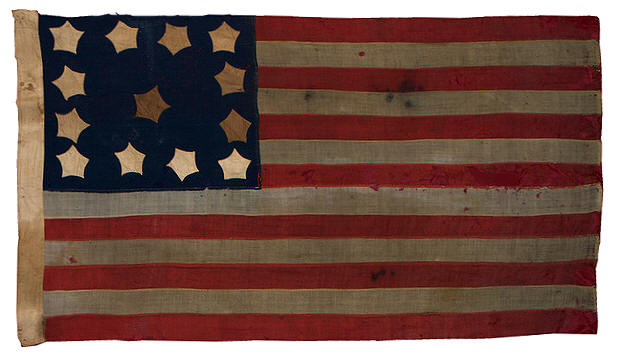
This extraordinary flag
of 13 stars in the Trumbull Pattern is a national
treasure and likely dates to the late 18th or very early
19th century. It survives as
one of the earliest 13 star flags and a beautiful folk
art form of the American flag. The most striking
attribute of the flag is its unusually bold, nearly
pentagonal stars, which are double-appliqué, meaning
that each side of the flag has its own set of stars,
stitched back to back. Interestingly, the
irregular shape of the stars and their alignment are
carefully matched to their opposing counterpart.
The stars and hoist are made of a very finely woven
cotton fabric. The entire flag is hand stitched, and the
experienced seamstress carefully pieced and finished the
seams between the stripes on both sides of the flag.
The wool bunting appears to be a hand loomed wool, as
seen in earlier flags. The weave is especially
coarse, dense, and irregular. The red stripes are a dyed a carmine red, having
a very slight purplish tinge unlike any other flags in
the Rare Flags collection. The coloration is indicative
of a cochineal-based dye. The hoist of the flag consists
of a sleeve nearly 3 inches wide, as expected for an 18th
century or very early 19th century flag.
|
The pattern of stars, a square of 12 with one center
star, is known as the Trumbull pattern after
Revolutionary War patriot and artist John Trumbull, who
painted this configuration of stars in at least three of
his works: The Battle of Princeton (1777), The Surrender
of General Burgoyne at Saratoga, New York (1777) and The
Surrender of Lord Cornwallis at Yorktown, Virginia,
(1781). Although it is unknown historically if this
pattern of flag was actually present at these battles,
Trumbull served as second personal aide to George
Washington and deputy adjutant-general for General
Horatio Gates, and had deep first-hand knowledge of the
war and the flags that would have been flown. He also is
known for meticulous attention to detail. Regardless of
whether or not this pattern of flag was actually present
on these battlefields, the pattern has become |
 |
|
Close up of the flag's
Wool Bunting and Fine Cotton Stars |
|
|
permanently associated with
his name. Antique flags in the Trumbull
pattern are extremely rare. For flag
collectors, Trumbull pattern flags are one of
the rarest 13 star patterns when compared to
other 13 star patterns such as the 3-2-3-2-3
pattern or the 4-5-4. Perhaps ten or fewer
are known in the pattern, and the discovery of
any new examples, as in the case of this flag,
which formerly belonged to a judge from Texas,
is a fantastic and exciting event. |
|

